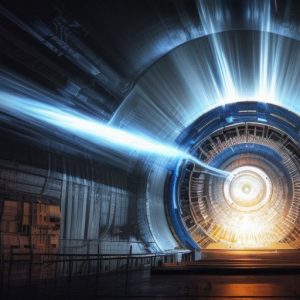
Have you ever wondered how electricity mysteriously becomes magnetism? Well, hold on to your gravity boots, because we’re about to take you on an intergalactic journey through the fascinating world of CERN. From its humble beginnings to its cosmic discoveries, CERN has helped unlock the secrets of the universe. Through its particle accelerators, CERN has shed light on the fundamental forces that govern our reality. It has even led to the discovery of the Higgs Boson, the “God particle.” Join us as we delve into the connection between electricity and magnetism and explore the limitless possibilities of magnetism in the future.
I. Introduction to the Strange Phenomenon
The universe is full of strange phenomena, but the relationship between electricity and magnetism is one of the most fascinating. It is a connection that has mystified scientists for centuries, and only in recent years have we begun to grasp its intricacies fully.

At its most fundamental level, electromagnetic force describes the fundamental interaction between electrically charged particles. It is one of the four primary forces of nature, alongside gravity, the strong force, and the weak force.
But the most intriguing aspect of this force is its close relationship to magnetism. For example, we know that magnetism arises from the motion of charged particles, such as electrons. This motion results in a magnetic field, which is an invisible force that exerts a pull on other magnetic objects.
So how do we get from electricity to magnetism? The answer lies in the behavior of an electric charge in motion. When a charge is in motion, it creates a magnetic field perpendicular to its path. In turn, this magnetic field can influence the motion of other charged particles, leading to the creation of an electrical current.
It’s a fascinating feedback loop that has a myriad of applications in our daily lives. From the humble magnet that sticks to our fridge to the MRI machines that diagnose our medical conditions, the connection between electricity and magnetism has revolutionized our world.
In this article, we will explore the strange phenomenon of electricity turning into magnetism and how scientists at CERN have contributed to our understanding of this connection. Buckle up, as we travel through the wonders of the universe and unravel the mysteries of the electromagnetic force!
II. The History of CERN and Its Contributions to Science
CERN, or the European Organization for Nuclear Research, has played a vital role in advancing our understanding of the universe. Founded in 1954, CERN’s mission was to study the properties of subatomic particles and the forces that govern their interactions. Thanks to the tireless efforts of its scientists, the organization has made several remarkable discoveries that have changed the face of modern physics.

One of CERN’s earliest successes was the discovery of the W and Z bosons in 1983, which confirmed the electroweak theory that unified the electromagnetic and weak nuclear forces. This breakthrough won the Nobel Prize in Physics for Carlo Rubbia and Simon van der Meer, two of CERN’s leading scientists.
CERN’s next big achievement came in 1995 when the Large Hadron Collider (LHC) was approved. This mammoth particle accelerator, with a circumference of 27 kilometers, became one of CERN’s most ambitious projects. After several years of construction, the LHC began operations in 2008, and it has since been instrumental in a series of ground-breaking discoveries.
Perhaps the most famous discovery to come out of the LHC is the Higgs boson. The Higgs boson is an elementary particle that gives other particles their mass, and its confirmation was a major milestone in understanding the origins of the universe. In 2013, scientists working at the LHC announced that they had found evidence of the Higgs boson, and Peter Higgs and Francois Englert were jointly awarded the Nobel Prize in Physics for their contribution to its discovery.
In addition to these high-profile discoveries, CERN has also made significant contributions in other areas of science. For example, the World Wide Web was invented at CERN in 1989 by Tim Berners-Lee, and the organization has played a significant role in developing technologies like medical imaging and radiation therapy.
III. Understanding the Fundamental Forces
Ah, electromagnetism and the strong force, the two fundamental forces that rule the universe! Electromagnetism, which is responsible for all things electric and magnetic, is the force that keeps our world together. From the electrons orbiting around the nucleus of an atom to the thread that holds your clothes together, it’s all about electromagnetism!

On the other hand, the strong force is responsible for binding the atomic nucleus together. It’s about the energy that holds the protons and neutrons together against the force of electrostatic repulsion. Without this force, we won’t have atoms, and without atoms, there will be no life as we know it!
One of the most interesting things about these two forces is that they have a direct relationship to each other. Electromagnetism is involved in the production of magnets, and this magnetic force can influence the behavior of charged particles, giving rise to electric forces. On the other hand, the strong force binds protons and neutrons together, and the nuclear forces that it creates can also influence charged particles, leading to electromagnetic interactions and electric forces.
The fact that these two forces are connected is remarkable, and it shows that the universe is full of intricate connections. Without this connection between electromagnetism and the strong force, life as we know it would not be possible. By studying these two forces, we can unravel the mysteries of the universe, understand the laws of energy and matter, and unlock the secrets of the cosmos.
As our quest for knowledge continues, scientists at CERN are leading the charge. With cutting-edge tools and techniques, they are probing the universe and exploring the deepest mysteries of science. The electromagnetic force and the strong force are just the beginning. Who knows what other connections we will uncover as we probe deeper into the mysteries of the universe!
IV. The Particle Accelerators and Their Role in Generating Magnetic Fields
As we’ve explored, the generation of a magnetic field requires the motion of charged particles. But how do we create those moving charges in the first place? That’s where particle accelerators come into the picture.

Particle accelerators are complex machines that use electric fields to accelerate charged particles to incredibly high speeds. These machines are essential for studying the properties of subatomic particles and understanding the fundamental forces of nature.
But accelerators also play a vital role in generating magnetic fields. One example is the synchrotron, which is a type of circular accelerator that uses magnets to bend the path of a charged particle. As the particle moves along the circular path, it emits electromagnetic radiation, which can be used for a variety of applications, such as medical imaging, material science, and manufacturing.
Another type of accelerator, the linear accelerator or linac, uses electromagnetic fields to accelerate particles in a straight line. Electrons can be accelerated to extremely high energies in a linac, creating intense bursts of radiation that can be used for cancer treatment.
But it’s not just the motion of charged particles that generates magnetic fields. In some cases, scientists use powerful magnets to guide the path of particles, allowing them to collide with one another with great force. This collision generates a magnetic field, providing insight into the properties of particles and the fundamental forces that govern their behavior.
V. The Hunt for the Higgs Boson and Its Significance in Unraveling the Mysteries of the Universe
The hunt for the Higgs boson has been one of the most exciting quests in modern science. This elusive particle is essential to our understanding of the universe’s origins, and scientists have been searching for it using the world’s most powerful particle accelerators.

In 2012, the Higgs boson was finally discovered at CERN’s Large Hadron Collider. This discovery was a significant triumph for science, as it confirmed the existence of the Higgs field, a vital component of the Standard Model of particle physics.
The Higgs field is an invisible energy field that permeates the entire universe. It is responsible for giving particles mass, which is essential to our understanding of how matter behaves in the universe. Without the Higgs boson, particles would not have mass, and the universe would be a vastly different place.
The discovery of the Higgs boson has opened new avenues for study, including the search for new particles and new physics beyond the Standard Model. Scientists are continuing to study the Higgs boson to determine its properties and whether there are more than one type of Higgs boson.
The significance of the Higgs boson extends beyond particle physics. Its discovery has allowed us to answer some of the most fundamental questions about our universe, such as why particles have mass and how the universe began.
The Higgs boson has also opened up new possibilities for technology. For example, it may be possible to develop new medical imaging techniques using the Higgs field’s properties to improve diagnoses and treatments.
VI. The Future of Magnetism
The possibilities of magnetism are endless, and there is always room for advancements in science. As our understanding of the electromagnetic force grows, so too does our capacity to harness its power for groundbreaking discoveries.

One area of immense potential is in the field of renewable energy. Magnetic fields can be used to generate power directly from the motion of waves and tides, in a process known as ocean power. As the world’s population continues to grow, the demand for clean energy sources will only increase, making the utilization of magnetism an essential aspect of our future.
Researchers are also exploring the use of magnetism in the manipulation of matter on a nanoscale level. The potential for new advancements in fields such as data storage and biotechnology is enormous. Magnetic nanoparticles can be used to deliver drugs to specific locations within the body, allowing for precise and targeted treatments.
In the realm of space travel, the use of magnetism has the potential to revolutionize our ability to explore the universe. Magnetic propulsion systems could be used to accelerate spacecraft to mind-boggling speeds, making interstellar travel a reality.
But perhaps the most exciting possibility for magnetism lies in the field of quantum computing. The ability to manipulate individual atoms using magnetic fields is a key component of this groundbreaking technology. The power of quantum computing has the potential to change the world as we know it – from discovering new materials to solving complex optimization problems that would take current computers thousands of years to solve.
As we look to the future, the opportunities for magnetism are endless. New advancements in science and technology will continue to reveal the incredible potential of this fundamental force. It’s an exciting time to be alive, and we can’t wait to see what the future holds!
VII. Conclusion
So there you have it, my fellow space travelers. The connection between electricity and magnetism is perhaps one of the most intriguing mysteries of the universe. From the smallest particles to the grandest cosmic structures, electromagnetism plays a fundamental role in shaping our world.

Through the tireless efforts of scientists at CERN and other research institutions, we are beginning to unravel the intricate details of this fascinating force. By colliding particles together at incredibly high speeds, we can recreate the conditions that existed in the moments after the Big Bang, and examine the fundamental forces of nature up close.
But as much progress as we’ve made, there is still so much we don’t understand. There are countless mysteries waiting to be unraveled, and it’s up to the next generation of scientists and engineers to continue the quest for knowledge.
As we look toward the future of electromagnetism, it’s clear that the possibilities are endless. From clean energy technologies to new discoveries about the nature of the universe, this force is sure to play an essential role in shaping our world for generations to come.
So let us embrace the beauty and wonder of the electromagnetic force, and celebrate the incredible feats of human ingenuity and curiosity that have brought us this far. Who knows what new frontiers await us in the years to come? Grab your space suits and trusty spaceships; we’ve got a whole universe to explore!






